马承英语语音过关 Lesson14
- 格式:ppt
- 大小:5.43 MB
- 文档页数:38
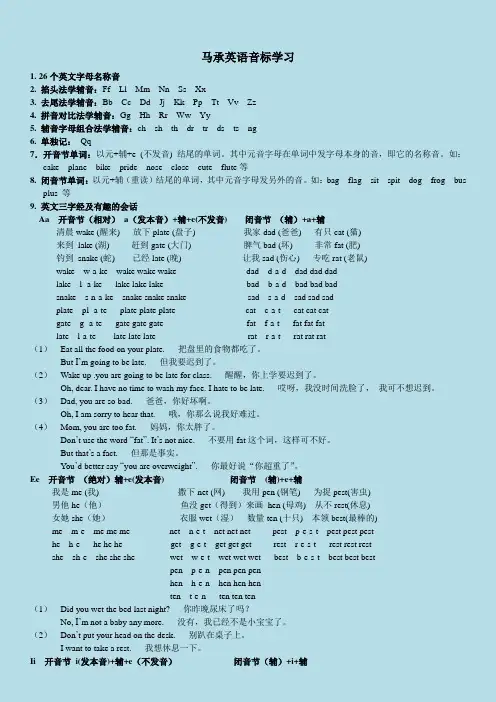
马承英语音标学习1. 26个英文字母名称音2. 掐头法学辅音:Ff Ll Mm Nn Ss Xx3. 去尾法学辅音:Bb Cc Dd Jj Kk Pp Tt Vv Zz4. 拼音对比法学辅音:Gg Hh Rr Ww Yy5. 辅音字母组合法学辅音:ch sh th dr tr ds ts ng6. 单独记:Qq7.开音节单词:以元+辅+e (不发音) 结尾的单词。
其中元音字母在单词中发字母本身的音,即它的名称音。
如:cake plane bike pride nose close cute flute等8. 闭音节单词:以元+辅(重读)结尾的单词,其中元音字母发另外的音。
如:bag flag sit spit dog frog busplus 等9. 英文三字经及有趣的会话Aa 开音节(相对)a(发本音)+辅+e(不发音) 闭音节(辅)+a+辅清晨wake (醒来) 放下plate (盘子) 我家dad (爸爸) 有只cat (猫)来到lake (湖) 赶到gate (大门) 脾气bad (坏) 非常fat (肥)钓到snake (蛇) 已经late (晚) 让我sad (伤心) 专吃rat (老鼠)wake w-a-ke wake wake wake dad d-a-d dad dad dadlake l- a-ke lake lake lake bad b-a-d bad bad badsnake s-n-a-ke snake snake snake sad s-a-d sad sad sadplate pl- a-te plate plate plate cat c-a-t cat cat catgate g- a-te gate gate gate fat f-a-t fat fat fatlate l-a-te late late late rat r-a-t rat rat rat(1)---Eat all the food on your plate. 把盘里的食物都吃了。
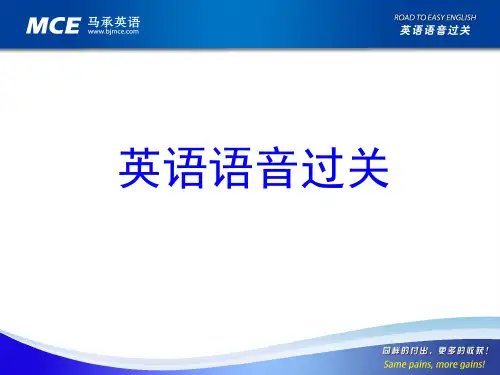
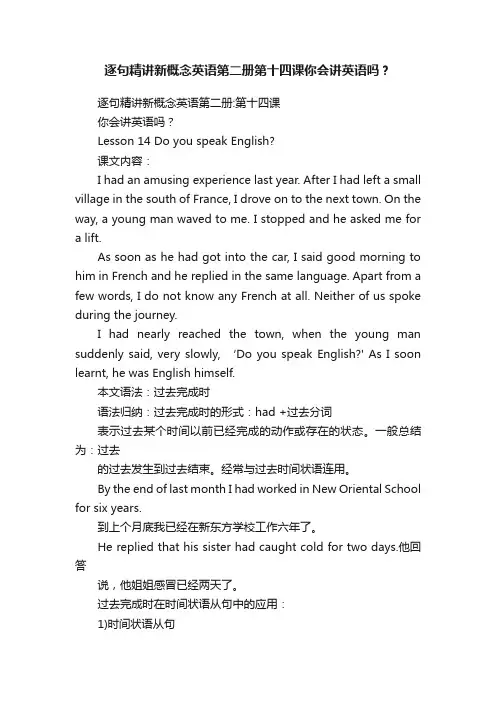
逐句精讲新概念英语第二册第十四课你会讲英语吗?逐句精讲新概念英语第二册:第十四课你会讲英语吗?Lesson 14 Do you speak English?课文内容:I had an amusing experience last year. After I had left a small village in the south of France, I drove on to the next town. On the way, a young man waved to me. I stopped and he asked me for a lift.As soon as he had got into the car, I said good morning to him in French and he replied in the same language. Apart from a few words, I do not know any French at all. Neither of us spoke during the journey.I had nearly reached the town, when the young man suddenly said, very slowly, ‘Do you speak English?' As I soon learnt, he was English himself.本文语法:过去完成时语法归纳:过去完成时的形式:had +过去分词表示过去某个时间以前已经完成的动作或存在的状态。
一般总结为:过去的过去发生到过去结束。
经常与过去时间状语连用。
By the end of last month I had worked in New Oriental School for six years.到上个月底我已经在新东方学校工作六年了。
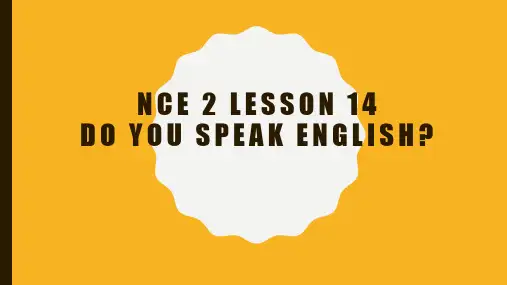
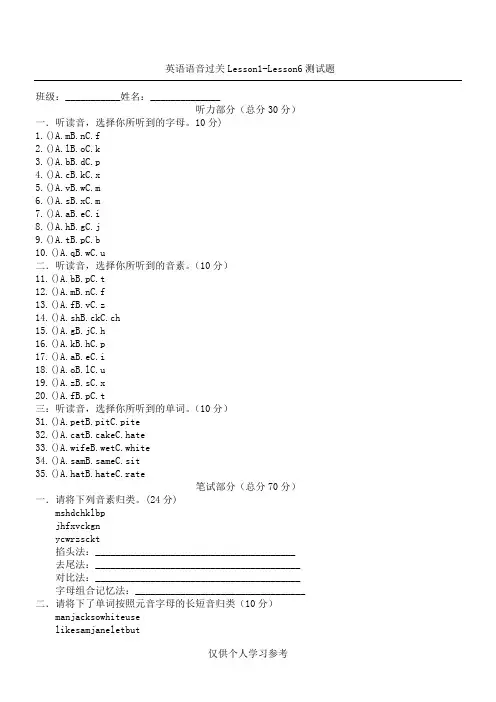
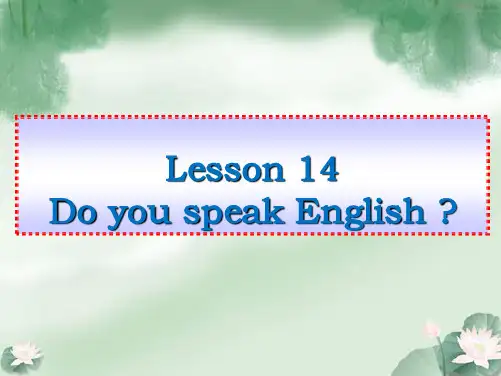
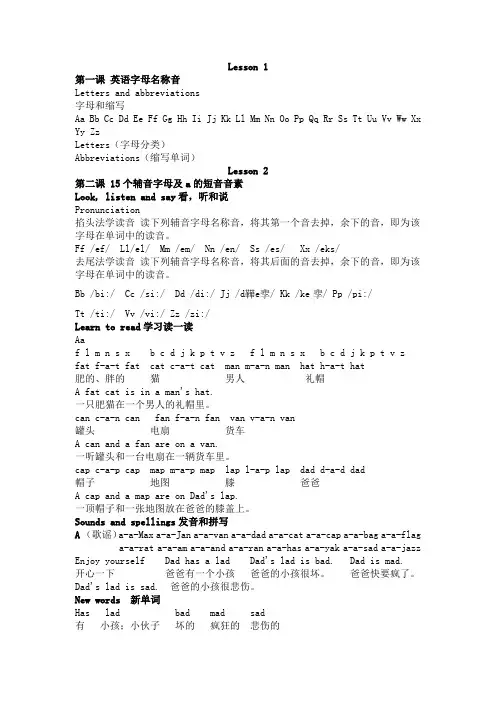
第一课英语字母名称音Letters and abbreviations字母和缩写Aa Bb Cc Dd Ee Ff Gg Hh Ii Jj Kk Ll Mm Nn Oo Pp Qq Rr Ss Tt Uu Vv Ww Xx Yy ZzLetters(字母分类)Abbreviations(缩写单词)Lesson 2第二课 15个辅音字母及a的短音音素Look, listen and say看,听和说Pronunciation掐头法学读音读下列辅音字母名称音,将其第一个音去掉,余下的音,即为该字母在单词中的读音。
Ff /ef/ Ll/el/ Mm /em/ Nn /en/ Ss /es/ Xx /eks/去尾法学读音读下列辅音字母名称音,将其后面的音去掉,余下的音,即为该字母在单词中的读音。
Bb /bi:/ Cc /si:/ Dd /di:/ Jj /d e/ Kk /ke/ Pp /pi:/Tt /ti:/ Vv /vi:/ Zz /zi:/Learn to read学习读一读Aaf l m n s x b c d j k p t v z f l m n s x b c d j k p t v zfat f-a-t fat cat c-a-t cat man m-a-n man hat h-a-t hat肥的、胖的猫男人礼帽A fat cat is in a man's hat.一只肥猫在一个男人的礼帽里。
can c-a-n can fan f-a-n fan van v-a-n van罐头电扇货车A can and a fan are on a van.一听罐头和一台电扇在一辆货车里。
cap c-a-p cap map m-a-p map lap l-a-p lap dad d-a-d dad帽子地图膝爸爸A cap and a map are on Dad's lap.一顶帽子和一张地图放在爸爸的膝盖上。
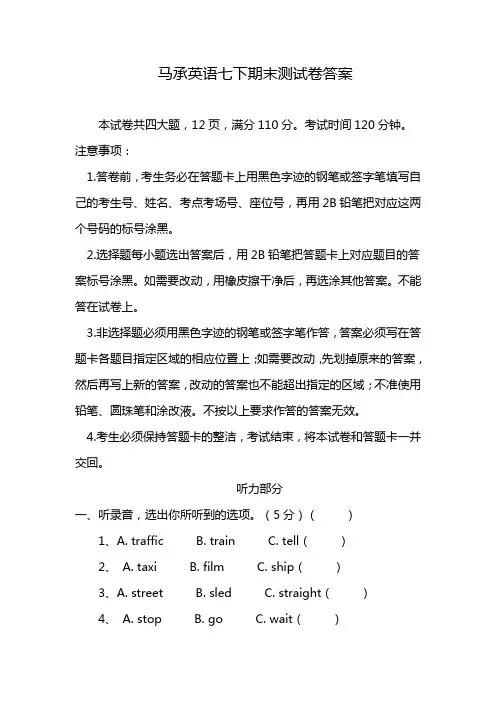
马承英语七下期末测试卷答案本试卷共四大题,12页,满分110分。
考试时间120分钟。
注意事项:1.答卷前,考生务必在答题卡上用黑色字迹的钢笔或签字笔填写自己的考生号、姓名、考点考场号、座位号,再用2B铅笔把对应这两个号码的标号涂黑。
2.选择题每小题选出答案后,用2B铅笔把答题卡上对应题目的答案标号涂黑。
如需要改动,用橡皮擦干净后,再选涂其他答案。
不能答在试卷上。
3.非选择题必须用黑色字迹的钢笔或签字笔作答,答案必须写在答题卡各题目指定区域的相应位置上;如需要改动,先划掉原来的答案,然后再写上新的答案,改动的答案也不能超出指定的区域;不准使用铅笔、圆珠笔和涂改液。
不按以上要求作答的答案无效。
4.考生必须保持答题卡的整洁,考试结束,将本试卷和答题卡一并交回。
听力部分一、听录音,选出你所听到的选项。
(5分)()1、A. traffic B. train C. tell()2、A. taxi B. film C. ship()3、A. street B. sled C. straight()4、A. stop B. go C. wait()5、A. next weekend B. today C. tomorrow二、听录音,选择恰当的答语。
(10分)()1、A. You can take the No.15 busB. You can see the No.15 bus.C. Go straight and you can see the cinema.()2、A. It’s the post officeB. It’s next to the post office.C. It’s next to the supermarket.()3、A. No, it isn’t.B. No, there isn’t.C. Yes, there isn’t.()4、A. You’re right.B. You’re welcome.C. see you.三、听录音,判断下列句子与你所听内容是(T)否(F)一致。
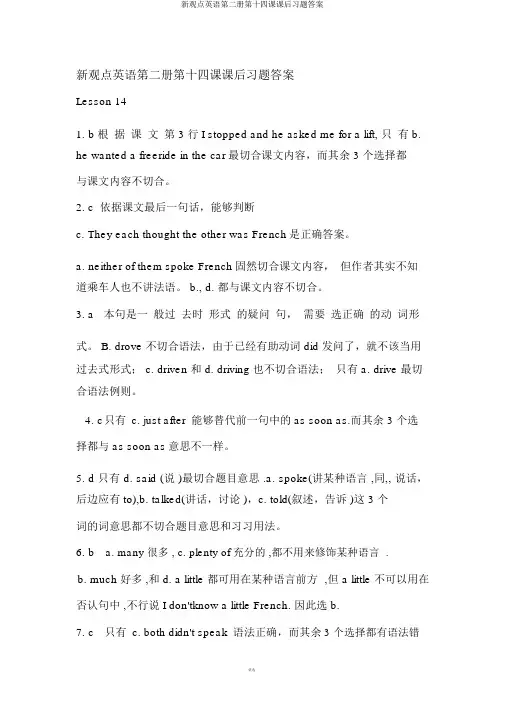
新观点英语第二册第十四课课后习题答案Lesson 141. b 根据课文第 3 行 I stopped and he asked me for a lift, 只有 b. he wanted a freeride in the car最切合课文内容,而其余 3 个选择都与课文内容不切合。
2.c 依据课文最后一句话,能够判断c. They each thought the other was French是正确答案。
a. neither of them spoke French固然切合课文内容,但作者其实不知道乘车人也不讲法语。
b., d. 都与课文内容不切合。
3.a 本句是一般过去时形式的疑问句,需要选正确的动词形式。
B. drove 不切合语法,由于已经有助动词 did 发问了,就不该当用过去式形式; c. driven 和 d. driving 也不切合语法;只有 a. drive 最切合语法例则。
4. c只有c. just after能够替代前一句中的as soon as.而其余 3 个选择都与 as soon as意思不一样。
5.d 只有 d. said (说 )最切合题目意思 .a. spoke(讲某种语言 ,同,, 说话,后边应有 to),b. talked(讲话,讨论 ),c. told(叙述,告诉 )这 3 个词的词意思都不切合题目意思和习习用法。
6. b a. many 很多 , c. plenty of 充分的 ,都不用来修饰某种语言 .b. much 好多 ,和 d. a little 都可用在某种语言前方,但 a little 不可以用在否认句中 ,不行说 I don'tknow a little French. 因此选 b.7. c只有c. both didn't speak语法正确,而其余3 个选择都有语法错优选误,因此我们只好选 c.8.b 前一句中的短语 on the way 是“在路上”的意思,只有b.during the writer’sjourney(在作者旅途中 )同这个短语意思最靠近,而此外 3 个选择都与它的意思不一样。
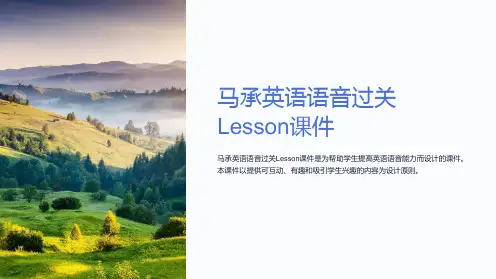
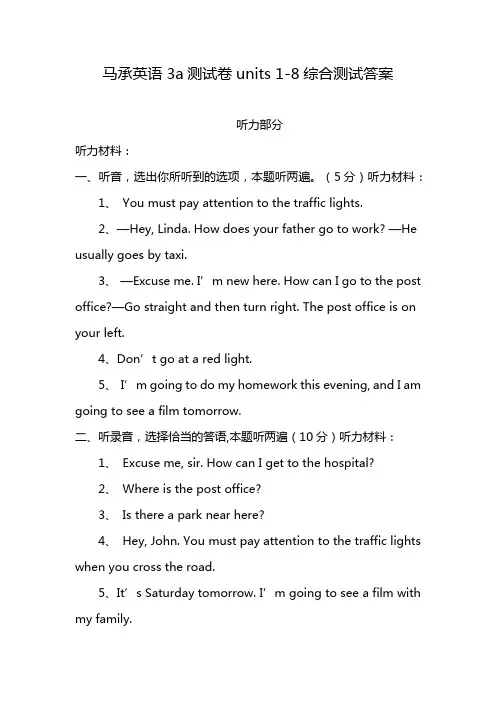
马承英语3a测试卷units 1-8综合测试答案听力部分听力材料:一、听音,选出你所听到的选项,本题听两遍。
(5分)听力材料:1、You must pay attention to the traffic lights.2、—Hey, Linda. How does your father go to work? —He usually goes by taxi.3、—Excuse me. I’m new here. How can I go to the post office?—Go straight and then turn right. The post office is on your left.4、Don’t go at a red light.5、I’m going to do my homework this evening, and I am going to see a film tomorrow.二、听录音,选择恰当的答语,本题听两遍(10分)听力材料:1、Excuse me, sir. How can I get to the hospital?2、Where is the post office?3、Is there a park near here?4、Hey, John. You must pay attention to the traffic lights when you cross the road.5、It’s Saturday tomorrow. I’m going to see a film with my family.三、听录音,判断下列句子与你所听内容是(T)否(F)一致,本题听两遍。
(10分)听力材料:1、—Is there a new cinema in your city? —No, there isn’t. But there is a new bookstore in my city.2、—Where are you going tomorrow? —I’m walking to the library.3、—How can I get to the post office? —Turn left at the zoo.4、—What are you going to do this afternoon,Mike? —I’m going to play football.5、—Where are you going next week, Tina? —I’m going to Beijing with my sister.一、听录音,选出你所听到的选项。
新概念英语第二册第14课:Do you speak English?Lesson 14 Do you speak English?你会讲英语吗? First listen and then answer the question.听录音,然后回答以下问题。
Did the young man speak English?I had an amusing experience last year.去年我有过一次有趣的经历After I had left a small village in the south of France,I drove on the next town.在离开法国南部的一个小村庄后,我继续驶往下一个城镇On the way, a young man waved to me. I stopped and he asked me for a lift.途中,一个青年人向我招手。
我把车停下,他向我提出要求搭车As soon as he had got into the car, I said good morning to him in French and he replied in the same language.他一上车,我就用法语向他问好,他也同样用法语回答我Apart from a few words, I do not know any French at all. Neither of us spoke during the journey.除了个别几个单词外,我根本不会法语I had nearly reached the town, when the young man suddenly said, very slowly, 'Do you speak English?'旅途中我们谁也没讲话。
就要到达那个镇时,那青年突然开了口,慢慢地说道“你会讲英语吗?”As I soon learnt, he was English himself!我很快了解到,他自己就是个英国人!New words and expressions 生词和短语amusingadj. 好笑的,有趣的experiencen. 经历wavev. 招手liftn. 搭便车replyv. 回答languagen. 语言journeyn. 旅行Notes on the text课文注释1 I drove on to the next town.我继续驶往下一个城镇。
教案:Lesson 14 May I Go to Beijing?一、教学目标1. 知识目标(1)能够听懂、会说、会读本课的生词和重点句子。
(2)能够用“May I?”提出请求,并用“Yes, you may.”和“No, you may not.”回答。
(3)能够运用所学知识描述将来的计划。
2. 能力目标(1)能够正确使用动词的一般将来时。
(2)能够运用所学知识进行简单的交流和讨论。
3. 情感目标培养学生对北京等中国城市的兴趣和热爱,激发学生学习英语的兴趣。
二、教学内容1. 主题:Lesson 14 May I Go to Beijing?2. 重点句子:May I go to Beijing?No, you may not.Yes, you may.3. 生词:Beijing 北京go to 去may not 不可以may 可能No, you may not. 不可以,你有play 玩Yes, you may. 可以,你有三、教学重点与难点1. 重点:能够听懂、会说、会读本课的生词和重点句子,能够正确使用动词的一般将来时。
2. 难点:动词的一般将来时的运用。
四、教具与学具准备1. 教具:课件、黑板、粉笔2. 学具:课本、练习本、文具五、教学过程1. 导入(5分钟)通过问答的方式引导学生谈论他们将来的计划,从而引入本课的主题。
2. 展示(10分钟)(1)教师出示生词和重点句子,引导学生跟读。
(2)通过图片和情景展示,让学生理解一般将来时的用法。
3. 练习(10分钟)(1)学生分组进行角色扮演,运用所学知识进行对话。
(2)完成课本练习题,巩固所学知识。
4. 应用(5分钟)学生分成小组,讨论并制定一个未来的计划,然后向全班展示。
六、板书设计1. May I go to Beijing?3. No, you may not.4. Yes, you may.七、作业设计1. 抄写生词和重点句子。
2. 完成课后练习题。
外研社《英语初级听力》第14课课文翻译Lesson FourteenSection One:Tapescript.Dialogue 1:— I want to fly to Geneva on or about the first.—I’ll just see what there is.—I want to go economy, and I’d prefer the morning.— Lufthansa Flight LH 203 leaves at 0920.— What time do I have to be there?— The coach leaves for the airport at 0815.—我想在一号或一号前后飞往日瓦。
—我来查一下有没有。
—我想要经济舱,最好早上起飞。
—汉莎航空LH 203班机早上9:20起飞。
—我什么时间到那里呢?—大巴会在8:15出发去机场。
Dialogue 2:—You must have some more chicken.—No, thanks. I’m supposed to be slimming.—Can’t I tempt you?—Well, maybe I could manage a very small piece.—你一定得多来些鸡肉—不了,。
我应当减肥了。
—我都劝不动你吗?—好吧,也许我可以吃一小块。
Dialogue 3:—I expect you could do with a cup of tea, couldn’t you?—I’d rather have a cup of coffee, if you don’t mind.— Milk andsugar?— A milky one without sugar, please.—我想你可以喝杯茶,对吗?—如果你不介意的话,我想要一杯咖啡。
—加奶和糖吗?—加奶不加糖,。
马承1A第十四次课教学计划一、教学课题:Lesson 8二、教学内容:1、第八单元对话1和2 2、语法:单数句子变复数句子二、教学目标:1.能熟读并背诵对话1或22.理解并掌握单数句子变复数句子用法三、教学重点:1、第八单元对话1和2 2、语法:单数句子变复数句子四、教学难点:语法:单数句子变复数句子五、教学准备:板书设计、图卡、六、教学课时:3课时七、教学过程:1、热身:What’s this?What’s this? What’s this? What’s this? What? What?It’s a bat. It’s a bat. It’s a bat, bat, bat.What’s this? What’s this? What’s this? What? What?It’s a ball. It’s a ball. It’s a ball, ball, ball.2、单词Remember in groupsthese those beautiful peacock eyespring summer autumn winter seasontoday tiger monkey birthday eleven candleyellow white colour balloon操练方式:传卡,猜卡,弹卡,指卡,摸卡,顶卡,开火车,萝卜蹲,中英互译任选三个方法来复习单词3、对话1和2Little boy MumWhat, this? peacock.beautiful, these, monkeys, Yes,those, dogs, No, foxes.Those, big cats, No, tigers.用简笔画和关键词来教授和复述对话,采取两组PK制,尤其是What’s this?What are those?句型的问答要重点操练,为后面的语法来做好准备。
对话2Jane Markbirthday, How old,11, What, these?birthday candles, What, those?pictures, balloons, beautiful!用简笔画和关键词来教授和复述对话,采取两组PK制,尤其是What are those\these?句型的问答要重点操练,为后面的语法来做好准备。